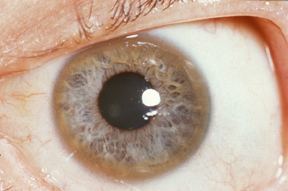Specialty ophthalmology ICD-9-CM 371.14 | ICD-10 H18.0 DiseasesDB 30056 | |
 | ||
Kayser–Fleischer rings (KF rings) are dark rings that appear to encircle the iris of the eye. They are due to copper deposition in part of the cornea (Descemet's membrane) as a result of particular liver diseases. They are named after Dr. Bernhard Kayser and Dr. Bruno Fleischer, the German doctors who first described them in 1902 and 1903. Initially thought to be due to the accumulation of silver, they were first demonstrated to contain copper in 1934.
Contents
Detection
As Kayser–Fleischer rings do not cause any symptoms, it is common for them to be identified during investigations for other medical conditions. In certain situations, they are actively sought; in that case, the early stages may be detected by slit lamp examination before they become visible to the naked eye.
Appearance
The rings, which consist of copper deposits where the cornea meets the sclera, in Descemet's membrane, first appear as a crescent at the top of the cornea. Eventually, a second crescent forms below, at 6 o'clock, and ultimately completely encircles the cornea.
Associations
Kayser–Fleischer rings are a sign of Wilson's disease, which involves abnormal copper handling by the liver resulting in copper accumulation in the body and is characterised by abnormalities of the basal ganglia of the brain, liver cirrhosis, splenomegaly, involuntary movements, muscle rigidity, psychiatric disturbances, dystonia and dysphagia. The combination of neurological symptoms, a low blood ceruloplasmin level and KF rings is diagnostic of Wilson's disease.
Other causes of KF rings are cholestasis (obstruction of the bile ducts), primary biliary cirrhosis and "cryptogenic" cirrhosis (cirrhosis in which no cause can be identified).
